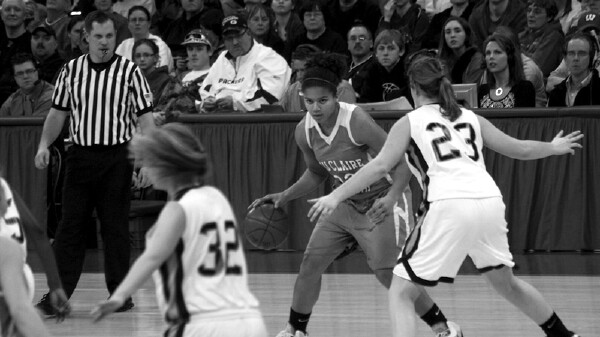Multiplication Problem
when it comes to high school sports, urban vs. rural may matter more than public vs. private

at the Kohl Center in 2011.
Dominance in sports comes for many reasons. In the pros, large markets with big-moneyed advertisers and high-dollar media rights can fund hefty salaries for top players. Other teams have particularly wealthy owners who do not mind spending huge sums on their team’s rosters. Still others hire intelligent front offices and coaches who find the right talent regardless of the economics of their sport, or develop a reputation and legacy of winning that draws ever more players to their programs.
Some of these reasons apply to high school athletics – yes, even money, in its own way – occasionally leading to pleas for balance. Some WIAA members in Wisconsin recently proposed such a remedy. The problem necessitating a remedy? The perceived advantage of private school teams over smaller public school teams in high-profile state tournaments.
Not every private school does better than similarly sized public schools; McDonell and Immanuel Lutheran have the same number of basketball trophies in the last decade-plus as most schools in the Chippewa Valley: zero.
This problem – if it truly exists – never appeared before 2000, when the parochial school-oriented WISSA was merged into the WIAA. Since that time, you may have noticed a good number of private schools – such as Wisconsin Lutheran or Racine St. Catherine’s or even Regis here in Eau Claire – do quite well at state, especially in basketball. Small public schools have noticed as well. What seems to be a preponderance of private school success at state has led to a call to even the playing field.
A prime question is: Which playing field to level? Numerous states have dealt with this seeming unevenness in prep athletic success, and a common response is the so-called multiplier for private schools. When a multiplier is applied, each student at such a school counts as more than a single student at a public school.
A little confused? Take Wisconsin’s recently proposed remedy: the 1.65 multiplier. Through this proposal, enrollment figures at Regis (and McDonell, La Crosse Aquinas, etc.) would be multiplied by 1.65 for the purposes of comparing them with the enrollment of public schools. Since athletic divisions are determined by enrollment size, this means private school enrollment would be boosted to a higher number, thus pushing private schools into higher, more competitive divisions.
If the problem is that private schools can charge tuition and gather added resources for their athletic programs, even with actual enrollment akin to a smaller public school, this could be a viable solution. Many tournaments since 2001 have featured at least one private school state champion. This, however, may not be the problem. Not every private school does better than similarly sized public schools; McDonell and Immanuel Lutheran have the same number of basketball trophies in the last decade-plus as most schools in the Chippewa Valley: zero.
The real playing field may be urban vs. rural schools. Rural schools face small and – in many cases these days – declining enrollment figures. In rural district, financing for facilities and salaries or from booster clubs isn’t at the same level as in urban areas. Essentially, this is the large market vs. small market problem we wince at in sports such as pro baseball and college football, only across the prep expanse of Wisconsin. Small public schools exist aplenty in close proximity to larger population centers, and their advantage over small towns in the middle of farm country remains with a private school multiplier.
What remedy can be found, if any? The increasing number of divisions has helped for decades; sure, we no longer have Hoosiers-style Cinderella stories, but those stories are essentially impossible in modern athletics. Could a multiplier be applied to all public schools within “X” number of miles of a major metropolitan area? If any school wins a certain number of championships, do they get upgraded to a higher-caliber division ... and then, do schools that consistently finish in last place get downgraded to provide balance? How about even more divisions?
The 1.65 multiplier proposal was tabled in April by the WIAA for further review. Come Sept. 1, a committee will tell us if this is the right path, or if another path needs be taken, or if we sit tight and take no path. If every student is to have an equal chance at a championship, the correct approach needs to be adopted. You will know a remedy will be successful when the most important multiplier is the number of western Wisconsin schools with state titles.




















